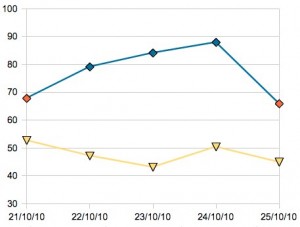I was looking over the HRV data of a very good age group runner the other day and noticed a couple of things that I want to share.
We used the export function on the Edit screen to send 6 months worth of data to my laptop, where I employed the spreadsheet program to create a line chart of both his HRV and resting heart rate (HR) against date.
I then asked him to go through his training & race diary, looking for interesting points and trends. One thing we quickly saw, which has been commented on by users and magazine reviewers, is that HRV acts as a forward looking health barometer. It is striking how far HRV falls immediately before the onset of bad colds & flu, giving you a timely warning to go easy or lay off training to avoid beating up your immune system and making it worse. What’s also interesting is that although colds & flu symptoms tend to last for two weeks, you are over the worst of it usually after the first 5d to 1 week, and that’s when the HRV picks up again, telling you that it’s OK to ease back into training again.
The second thing we looked at, was patterns of HRV immediately before a race, and how well that race went. Here, a striking observation was that a personal best performance on the 24th October was accompanied by a high morning HRV (blue line on the chart below) but also a higher than normal resting heart rate (yellow line). The taper started on the 22nd, following an amber HRV indication. The blue HRV line rises steadily over the next few days as the extra recovery allows the athlete’s body to recover and rebuild properly. You can see on the chart below that the gains start to diminish as the days go on, indicating that this taper was about right. Thinking about this combination of HR, HRV and performance, this is not so surprising. High HRV = well rested, and a higher than normal HR indicates that the sympathetic nervous system is preparing the body for a ‘fight or flight’ response. Exactly what you need on race day!
How to get that combination systematically is determined by your tapering strategy. Reducing the volume of training over a 5-7 day period allows the body to recover, rebuild, and renew, increasing your HRV. But if you just stop training completely, the HRV will go up for sure, but your body’s adrenaline making system will also switch off, leaving you feeling sluggish on race day. Many coaches advocate a few high intensity intervals during this time to give the body a ‘short sharp shock’ and thereby keep the fight or flight response primed & ready for action. I have recently come across an Australian sport science research paper that actually formalised this co-activation of HRV and HR by observing a competitive cyclist & determining a formula for their best race performances using HRV and the 3 day average of their training load (TRIMP). If this works more widely it could mean more scientific tapering & predictable race day performances.


Very interesting read
An EKG, and/or another type of one caleld the “Holtor Monitor”. This is one that you wear for 24 hours, so they can get readings over a long period of time and “catch” any irregular beats that may not happen in the dr.s office on on a 1-2 minute EKG session.I have palipations, too, due to mitral valve prolapse (non harmful) so I’ve been through all the tests.References :